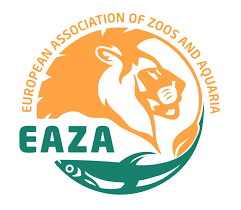We are pleased to announce the conclusion of the 2024 Bearded Vulture (Gypaetus barbatus) release season. The final release was “Tiscar,” a young vulture from Tallinn Zoo, who began her life in the last week of June 2024 at the Natural Park of Cazorla, Segura y Las Villas.
This season, two releases of Bearded Vultures took place in Cazorla, Spain. Before Tiscar, “Alfranca” and “Torreferrussa” were released in May. Their release event was successful and they adapted well to their new home, but sadly, we received some bad news a few days later.

Release of Torreferrussa and Alfranca in May
The first release happened on 13 May 2024 when “Alfranca” (B1219) and “Torreferrussa” (BG 1209) were released in the wild together. At the time of the release Alfranca was 91 days old and Torreferrussa a few days younger, 86 days old. They both hatched in different facilities within the Bearded Vulture Vulture Captive Breeding Network, managed by us on behalf of EAZA’s European Endangered Species Programme (Bearded Vulture EEP).
Alfrance came from Centro de Cría en Aislamiento Humano (CRIAH) in La Alfranca, Zaragoza, Aragón, the border between France and Spain, and Torreferrussa (as you might guess from her name) hatched in Torreferrussa Wildlife Center in Spain.
The captive-bred birds are always released at an average age of 90 days old, when they can eat alone, are strong enough to defend themselves against other birds of prey and are young enough to recognize the release site as their rearing place. This way, the nestlings can associate the place where they are released with the hatching area so that when they reach breeding age, around 8-10 years old, they select these places to breed.




The birds were released using the ‘hacking method’, which entails placing young birds at an artificial nest in suitable habitat to acclimatize to the natural environment before they take their first flights. Both birds adapted to their new surroundings quite quickly.
The hacking method imitates their natural way of fledging. The role of the parents at that time is the protection against predators, food supply and social contacts. This method substitutes these functions to a big part – however, sometimes exceptions occur.
Torreferrussa was attacked by a fox
Despite the hacking cave’s remote location and protective fencing designed to keep out terrestrial predators and safeguard the released birds, wildlife can sometimes still surprise us. Just 10 days after the release, a fox managed to enter the hacking cave and killed Torreferrussa. Unfortunately, she was not able to fly yet or to defend herself and her life in the wild ended before it truly had a chance to start.
This of course was a very sad moment for everyone, especially the monitoring team who had been observing the bird’s development. Even though the team did everything they could to provide a safe environment for the bird to survive, this time it was not possible to save the bird from the attack.
Alfranca survived the incident without any harm and has continued to develop well. Just recently, she took her first flights and is now soaring the skies of Andalusia.
Release of Tiscar in June
After this very sad incident with the Torreferrussa, extra care and consideration was taken with the release of Tiscar. That is why Tiscar was put in a hacking cage instead of a cave. This way, she will be protected against foxes and other predators in the area.


The bird traveled a long way from Tallinn Zoo in Estonia to her new home but is adapting quite well to the the warm Andalusian summer days and enjoying the beautiful scenery from her new home.
Hope prevails for the Bearded Vultures in Andalusia
Bearded Vultures disappeared from the skies of Andalusia in 1986 due to various threats including direct persecution, illegal wildlife poisoning and human disturbance of the nesting sites. The Junta de Andalucía teamed up with the former Fundación Gypaetus, and us here at the Vulture Conservation Foundation (VCF) to reintroduce the species in Andalusia by releasing captive-bred birds at different territories — Sierras de Cazorla, Segura, Castril and Las Villas.
The first successful breeding in the wild in Andalusia took place in 2015, when Tono, a male released in 2006, the first year of the project, and Blimunda, a female released in 2010, managed to fledge a young, aptly named Esperanza (hope). To date, a total of 96 specimens of this species have been released in Andalusia.
Breeding Bearded Vultures for conservation
The Vulture Conservation Foundation collaborates with 40+ European institutions to manage the Bearded Vulture captive breeding network, part of EAZA’s European Endangered Species Programme (Bearded Vulture EEP).
For decades, we have been releasing captive-bred Bearded Vultures across Europe to restore local populations in areas where the species became extinct or are under threat. VCF oversees global captive Bearded Vulture efforts, ensuring coordination and adherence to EEP guidelines. As coordinators of the Bearded Vulture Captive Breeding Network, we optimize breeding outcomes and maintain conservation efforts across Europe.
We are looking forward to observing Alfranca soaring the skies and hope to see the newest Cazorla resident Tiscar join her soon!







